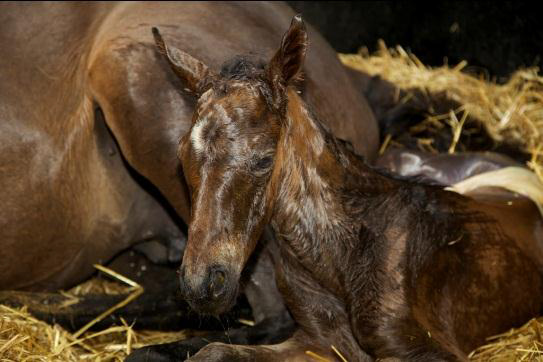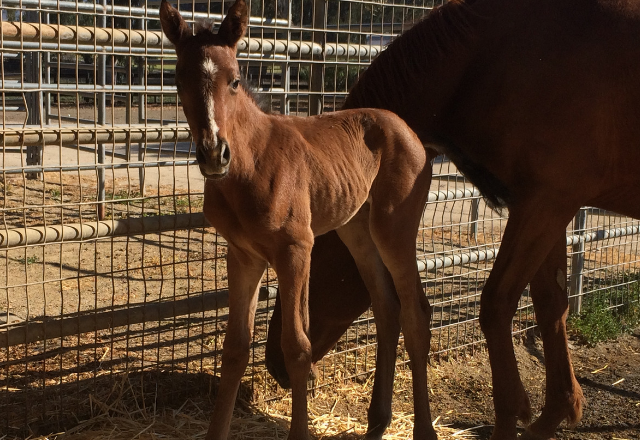When it comes to breeding horses, timing is everything. You only get one chance per month and only a handful of months each year, so proper planning is essential to produce a foal at a specific time.
WHAT IS THE BREEDING SEASON TIMELINE?
Begin by asking yourself what time next year you want the foal to arrive. Remember that your mares’ pregnancy will last almost a full year (335 days) so there is going to be some simple math to process. To illustrate, let’s pick a foaling date and work backwards.

FOR THE APRIL FOAL:
- For delivery of a foal in April of next year, your mare must conceive by May of this year.
- You should plan on giving her at least two breeding cycles in order for her to conceive so you will want to breed her first in April.
- Your mare will need at least one month prior to her anticipated breeding date for preparation, and so she should have a breeding assessment performed in March.
WHAT IS INCLUDED IN THE BREEDING ASSESSMENT?
- Physical Exam
- Assess overall health and breeding suitability
- Pre-Breeding Soundness Exam
- Uterine culture and cytology
- Ultrasound to assess current state of cycle and uterine status
- Vaginal exam for direct visual assessment of cervix
Physical Exam: Your veterinarian will assess her overall health and breeding suitability.
- Is she over or underweight?
- Is she systemically healthy?
- Is it too early or too late in her life to breed her?
- What is her prior reproductive history?
- Are her physical conformation, temperament and ability something you want to reproduce?
The answers to these questions will help determine if she is right for you to breed, and may even help you select your stallion. If you know your mare is in poor condition, you may need to start as much as 6 months earlier to return her to sound health before you breed.
Pre-breeding Soundness Exam: This includes palpation with ultrasound exam, uterine culture and cytology, and a vaginal exam.
- Ultrasound is used to determine the stage of her current cycle, and to determine if uterus contains fluid, cysts, or other abnormalities.
- Culture and cytology is used to screen for signs of any harmful bacteria, or the presence of an inflammatory process that may delay or prevent conception.
- A vaginal exam is performed using a speculum for direct visual assessment of the cervix to determine that she has healthy tissues, is free of adhesions, or urine pooling. It can also provide more information regarding the stage of her cycle.
YOUR MARE IS A GOOD BREEDING CANDIDATE!
We have tracked your mare’s cycle and we have bred her to the only stallion we could find that is worthy of mixing genes with her.
Now we have to wait to see if it worked. The same ultrasound your veterinarian used for her pre-breeding exam is used again to see if there is evidence of the beginnings of a foal.
- If the stallion was on distant shores and you bred her with shipped semen, you will want to get her an ultrasound at 14 – 15 following her breeding date so you can arrange for another shipment if she did not conceive.
- If the stallion is close by and she was bred by “live cover”, you can wait for signs of heat (if she shows heat well) or ultrasound her at 20 days post breeding. If she shows signs of heat she is not pregnant.
CONGRATULATIONS! YOUR MARE IS PREGNANT…… NOW WHAT?
So your precious cargo is finally on board. Can you just toss her hay until next spring and then start picking names and tiny pink or blue halters?
The first months are the most important to keep track of and you should plan on getting ultrasounds again at 35, 50, 90 and 150 days to ensure she is maintaining a healthy pregnancy. A significant percentage of mares experience early fetal loss, twins (which results in a loss of one or both foals), or non-viable pregnancies. Thinking she is pregnant when she is not, could cause you to lose the entire season. Now your foal is two years away.
Assuming that a good strong pregnancy is underway, the next step is maintaining your broodmare’s health, which means:
- Good nutrition
- Disease protection (Vaccination)
- Parasite control
- Exercise
Good Nutrition: If your mare is in good condition and on an appropriate diet when she is bred, there is no need to make changes just because she is in foal. Keep the basics in mind. As you get closer to her foaling, you should start thinking ahead about the nutrition needs of a lactating mare and developing foal.
Disease Protection: This is where you have to stay on top of things and keep records. Staying current on vaccinations is one of the most important things you can do to ensure a healthy foal next spring. Please see our vaccination guidelines to determine what your mare needs and then download our health record so you can keep a yearly calendar. To make it even easier, if you are enrolled in one of our WellCare EQ™ wellness programs or if you have received your vaccinations from The Equine Center veterinarians, you will automatically receive reminders when your mare is due for vaccinations.
Parasite Control: She is already feeding herself and a developing foal; you don’t want her to have to feed parasites as well. Worms can be damaging on a variety of fronts and could pose a significant threat to the pregnant mare. In addition to scheduled de-worming, The Equine Center recommends a daily de-wormer like Strongid C2x to prevent the buildup of parasites. Please see our Wellness page to learn more about this important management issue.
Exercise: It is understandable to worry about “her condition,” but she is carrying a foal not a tray of crystal glasses. Exercise is an essential part of a healthy pregnancy. You can continue to ride her all the way up to her last month as tolerated. If she has not been getting regular exercise, now is not the time to try to turn her into an athlete but regular turn out or some type of exercise is important as the pregnancy progresses. Standing around (especially if the mare is older) is unhealthy.
IN THE LAST MONTH:
At 300 days boost all of her annual vaccines, get her teeth checked, her feet trimmed (it will be easier to do before she foals than right afterwards with a foal at her side); administer a dose of dewormer, and if she has a Caslicks (sutures in her vulva) you will want your vet to open the Caslicks. Now you are in the final stretch!


[…] viagra 50mg coupon […]
[…] clomid buy […]
[…] cialis online no prescription […]
[…] where can i buy cialis […]
[…] 100mg white viagra s100 […]